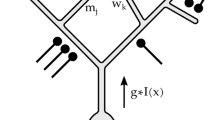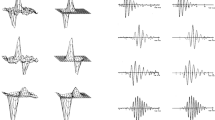Abstract
It is generally agreed upon that size invariance and the absence of spurious resolution are two requirements that characterize well behaved spatial samping in visual systems. We show that these properties taken together constrain the structure of receptive fields to a very large degree. Only those field structures that arise as solutions of a certain linear partial differential equation of the second order prove to satisfy these general constraints. The equation admits of complete, orthonormal families of solutions. These families have to be regarded as the possible receptive field families subject to certain symmetry conditions. They can be transformed into each other via unitary transformations. Thus a single representation suffices to construct all the others. This theory permits us to classify the possible linear receptive field structures exhaustively, and to define their internal and external interrelations. This induces a principled taxonomy of linear receptive fields.
Similar content being viewed by others
References
Babaud J, Witkin AP, Baudin M, Duda RO (1986) Uniqueness of the gaussian kernel for scale-space filtering. IEEE PAMI-8:26–33
Bijl P, Koenderink JJ (1989) Visibility of blobs with a gaussian luminance profile. Vision Res 29:447–456
Burton GJ, Haig ND, Moorhead IR (1986) A self-similar stack model for human and machine vision. Biol Cybern 53:397–403
Coggins JM, Jain AK (1985) A spatial filtering approach to texture analysis. Pattern Recogn Lett 3:195–203
Coggins JM, Fay FS, Fogarty KE (1986) Development and application of a three-dimensional artificial visual system. Cornput Methods Prog Biomed 22:69–77
Hummel RA, Kimia B, Zucker SW (1987) Deblurring gaussian blur. Comput Vision Graph Image Process 38:66–80
Jones JP, Palmer LA (1987) The two-dimensional spatial structure of simple receptive fields in cat striate cortex. J Neurophysiol 58:1187–1211
Jones JP, Palmer LA (1987) An evaluation of the two-dimensional Gabor filter model of simple receptive fields in cat striate cortex. J Neurophysiol 58:1233–1258
Koenderink JJ, van Doom AJ (1978) Visual detection of spatial contrast; Influence of location in the visual field, target extent and illuminance level. Biol Cybern 30:157–167
Koenderink JJ (1984) The structure of images. Biol Cybern 50:363–370
Koenderink JJ, van Doom AJ (1987) Representation of local geometry in the visual system. Biol Cybern 55:367–375
Koenderink JJ (1988) Operational significance of receptive field assemblies. Biol Cybern 58:163–171
Koenderink JJ, Richards W (1988) Two-dimensional curvature operators. J Opt Soc Am A5:1136–1141
Koenderink JJ (1989) A hitherto unnoticed singularity of scalespace. IEEE Trans Pattern Anal Machine Intell PAMI 11:1222–1224
Low K-C, Coggins JM (1990) Multiscale vector fields for image pattern recognition (in press)
Powell JL, Crasemann B (1961) Quantum mechanics. Addison-Wesley, Reading Mass
Watson A (1987) Efficiency of a model human image code. J Opt Soc Am A4:2401–2417
Young RA (1985) The gaussian derivative theory of spatial vision: Analysis of cortical cell receptive field line-weighting profiles. Gen Motor Res Tech Rep GMR-4920
Yuille AL and Poggio T (1985) Fingerprints theorems for zero crossings. J Opt Soc Am A5:683–692
SW Zucker, Hummel RA (1986) Receptive fields and the representation of visual information. Hum Neurobiol 5:121–128
Author information
Authors and Affiliations
Rights and permissions
About this article
Cite this article
Koenderink, J.J., van Doorn, A.J. Receptive field families. Biol. Cybern. 63, 291–297 (1990). https://doi.org/10.1007/BF00203452
Received:
Accepted:
Issue Date:
DOI: https://doi.org/10.1007/BF00203452




